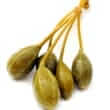Background
- Capers (Capparis spinosa) traditionally has been used for gas, liver function, heart disease, kidney disorders, parasitic worm infections, anemia, arthritis, gout, and as a tonic. Capers has also been used for low blood sugar. In early study, capers has shown antioxidant, liver protective, anti-inflammatory, antimicrobial, and sun protective properties.
- The combination therapy Liv-52® (Himalaya Herbals, India), which contains ferric oxide, capers, and several other herbal ingredients, may be an effective treatment for cirrhosis. The efficacy of capers alone for cirrhosis or other conditions remains unproven.
References
Natural Standard developed the above evidence-based information based on a thorough systematic review of the available scientific articles. For comprehensive information about alternative and complementary therapies on the professional level, go to . Selected references are listed below.
- Angelini G, Vena GA, Filotico R, et al. Allergic contact dermatitis from Capparis spinosa L. applied as wet compresses. Contact Dermatitis 1991;24(5):382-383.
View Abstract - Arena A, Bisignano G, Pavone B, et al. Antiviral and immunomodulatory effect of a lyophilized extract of Capparis spinosa L. buds. Phytother Res 2008;22(3):313-317.
View Abstract - Bonina F, Puglia C, Ventura D, et al. In vitro antioxidant and in vivo photoprotective effects of a lyophilized extract of Capparis spinosa L buds. J Cosmet Sci 2002;53(6):321-335.
View Abstract - Calis I, Kuruuzum A, Ruedi P. 1H-Indole-3 acetonitrile glycosides from Capparis spinosa fruits. Phytochemistry 1997;50(7):1205-1208.
- Calis I, Kuruuzum-Uz A, Lorenzetto PA, et al. (6S)-Hydroxy-3-oxo-alpha-ionol glucosides from Capparis spinosa fruits. Phytochemistry 2002;59(4):451-457.
- Huseini HF, Alavian SM, Heshmat R, et al. The efficacy of Liv-52 on liver cirrhotic patients: a randomized, double-blind, placebo-controlled first approach. Phytomedicine. 2005;12(9):619-624.
View Abstract - Jiang HE, Li X, Ferguson DK, et al. The discovery of Capparis spinosa L. (Capparidaceae) in the Yanghai Tombs (2800 years b.p.), NW China, and its medicinal implications. J Ethnopharmacol. 2007;113(3):409-420.
View Abstract - Mahasneh AM. Screening of some indigenous Qatari medicinal plants for antimicrobial activity. Phytother Res 2002;16(8):751-753.
View Abstract - Matthaus B, Ozcan M. Glucosinolate composition of young shoots and flower buds of capers (Capparis species) growing wild in Turkey. Journal of agricultural and food chemistry 2002;50(25):7323-7325.
- Lopez-Lopez A, Jimenez-Araujo A, Garcia-Garcia P, et al. Multivariate analysis for the evaluation of fiber, sugars, and organic acids in commercial presentations of table olives. J Agric Food Chem. 2007;55(26):10803-10811.
View Abstract - Panico AM, Cardile V, Garufi F, et al. Protective effect of Capparis spinosa on chondrocytes. Life Sci. 2005;77(20):2479-2488.
View Abstract - Romeo V, Ziino M, Giuffrida D, et al. Flavour profile of capers (Capparis spinosa L.) from the Eolian Archipelago by HS-SPME/GC-MS. Food Chemistry 2007;3:1272-1278.
- Sharaf M, el Ansari MA, Saleh NA. Quercetin triglycoside from Capparis spinosa. Fitoterapia 2000;71(1):46-49.
View Abstract - Tesoriere L, Butera D, Gentile C, et al. Bioactive components of caper (Capparis spinosa L.) from Sicily and antioxidant effects in a red meat simulated gastric digestion. J Agric Food Chem. 2007;55(21):8465-8471.
View Abstract - Yaniv Z, Dafni A, Friedman J, et al. Plants used for the treatment of diabetes in Israel. J Ethnopharmacol. 1987;19(2):145-151.
View Abstract







